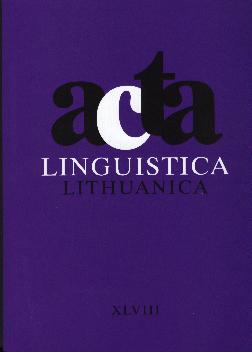Pastabos dėl lietuvių kalbėjimo tempo
Notes on Lithuanian speech rate
Author(s): Kristina Veličkaitė, Asta KazlauskienėSubject(s): Language and Literature Studies
Published by: Lietuvių Kalbos Institutas
Keywords: Lithuanian; phonetics; speech rate
Summary/Abstract: The article presents the results of an investigation into the general rate of Lithuanian speech. Few work has been done in this domain; the only comprehensive study is Girdenis & Lakienė (1975). The investigation is based on the rate of speech of eight individuals (four men and four women, belonging to two age groups) living in Kaunas. The average age of the younger group was 27, that of the older group 55,5. Each respondent was asked to talk on any freely chosen topic for a certain time (about 20 minutes). The overall amount of text produced by each of the respondents did not exceed 36000 syllables. The average number of syllables per second (syll./sec.) is chosen as an index of speech rate. The data show that the average rate of the respondents’ free narration is 3,8±0,6 syll./sec., the confidence interval is 3,2÷4,3 syll./sec. Additional tests were performed with texts read aloud. Two texts were read aloud by five different speakers. Preliminary results show that, on average, Lithuanians produce 4,6 syllables per second when reading aloud. Other indexes of speech rate are the number of words per minute and the number of phonemes per second. The average rate of speech of the respondents in our investigation is 107 words per minute. The average Lithuanian syllable contains 2,4 phonemes, so that our respondents pronounce an average number of 9 phonemes per second. An attempt was made to establish how speech rate varies during narration. For this purpose, each narrative was divided into four sections of 5 minutes each. No significant change in speech rate was observed. It is possible that changes in speech rate are individual and depend on the content of narration, which may be quicker or slower according to the topic. For this reason, considerable changes in speech rate may be observed in individual speakers during the same narration. The average speech rate of women is 4±0,4 syll,/sec. (3,4÷4,5 syll./sec.), that of men 3,6±0,9 syll./sec. (2,2÷4,9 syll./sec.). Comparing the averages for men and women we see that in the case of women (3,6; 3,8; 4,2; 4,3 skm./sec.) fluctuations in speech rate are less pronounced than in the case of men (2,6; 3,3; 3,6; 4,8 skm./sek.). Statistically, the difference between the speech rates of women and men is not significant: the calculated value of Student’s criterion is below the critical value: t(6)=0,910<t(0,95)=1,943; the confidence intervals overlap (2,2÷4,9 syll./sec. for men; 3,4÷4,5 syll./sec. for women). The average speech rate of the younger age group was 4,2±0,4 syll./sec. (3,5÷4,9 syll./sec.), that of the older age group 3,3±0,5 syll./sec. (2,5÷4,2 syll./sec.). Such a difference in rate is statistically significant: (t(6)=2,567>t(0,95)=1,943. Four respondents who enjoyed higher education spoke faster (4,1±0,6 syll./sec., 3,2÷5,1syll./sec.) than those with seondary education or a vocational training (3,4±0,5 syll./sec., 2,6÷4,3 syll./sec.), but these results cannot be relied on because the
Journal: Acta Linguistica Lithuanica
- Issue Year: 2003
- Issue No: 48
- Page Range: 49-57
- Page Count: 8
- Language: Lithuanian

